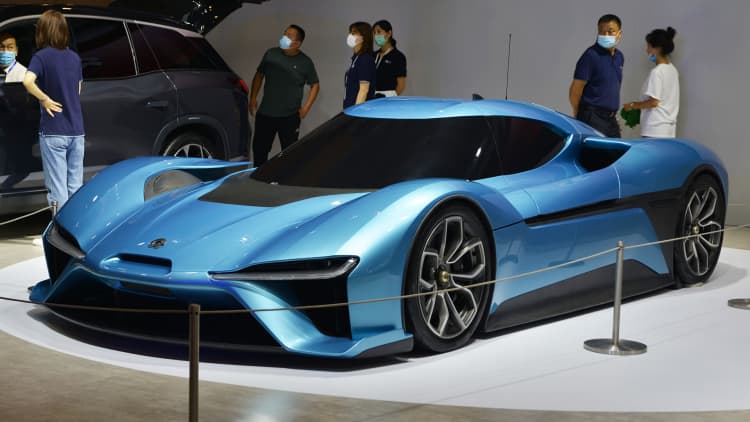
In China, new energy vehicles typically receive green license plates – which is often easier for residents to apply for versus the blue license plate of a traditional fuel-powered car.
Vcg | Visual China Group | Getty Images
BEIJING — While Chinese companies churn out new electric cars, local insurance firms think they’re more expensive to cover.
In general, the insurance premium for new energy cars — which includes electric — is about 20% higher than it would be for comparable traditional fuel-powered cars, said Wenwen Chen, director at S&P Global Ratings, who leads the firm’s research for China insurance.
Many factors go into determining pricing. But Chen said insurance companies find that the loss ratio — a measure of cost for insurers — tends to be higher for new energy vehicles than for internal combustion engine cars.
One of the main reasons she cited for a higher loss ratio is more accidents, especially more costly ones — since new energy vehicles often use parts that aren’t mass-produced yet.
In the U.S., insurance for electric cars also tends to be about 15% more expensive than that for combustion engine cars — primarily because electric cars in the U.S. tend to be luxury vehicles, according to Chase Gardner at Insurify, which compares car insurance rates in the U.S.
But repair costs are another reason for higher insurance prices, since “fewer places have the capability to service electric cars in the U.S.,” Gardner said. “Generally people who drive EVs end up paying lower maintenance costs over time. Again, the big question is, do you get into an accident?”

In the U.S., Insurify’s analysis of the U.S. market found there was no difference in accident rates among electric cars, hybrids and combustion engine cars.
But by official Chinese statistics, new energy vehicles in the country are more prone to fires than traditional fuel-powered ones. In the first quarter, 640 new energy vehicles reported fires, 32% higher than a year ago, according to the Ministry of Emergency Management’s Fire and Rescue Department.
That increase was far more than the 8.8% increase in fires for transportation vehicles overall, the ministry said. More recent figures weren’t available. The ministry didn’t respond to a CNBC request for comment.
For all of 2021, the ministry reported at least 3,000 new energy vehicle fires. It said the risk of fire was generally higher for such cars than for traditional vehicles, without disclosing specific figures.
The growing number of fires comes as the number of new energy vehicles has surged in China.
From January to August, 3.26 million new energy passenger cars were sold — more than double the same period last year and about 25% of all passenger cars sold in the country, according to the China Passenger Car Association. That share was about 15% last year.
In contrast, new energy vehicles remain a far smaller part of the U.S. auto market.
Hybrid, plug-in hybrid and electric vehicles accounted for 11% of light-duty vehicle sales in the U.S. in the fourth quarter of 2021, said the U.S. Energy Information Administration, citing data from Wards Intelligence. A more recent report wasn’t available. Light-duty vehicles also include pick-up trucks and vans.
A surge of new cars
China, home to the world’s largest auto market, has supported growth in new energy vehicles with policies that make it easier to get license plates, as well as subsidizing purchases.
For the first seven months of this year, tax exemptions for new energy vehicle purchases totaled 40.68 billion yuan ($5.9 billion) — and the equivalent of more than $1 billion in July alone, according to official figures. The tax administration said both amounts were more than twice what they were from a year ago.
Many Chinese companies have rushed to launch new energy vehicles, although it’s unclear what their specific accident risk is.
New energy vehicles tend to be simpler, especially in design, than internal combustion vehicles, said Cui Dongshu, secretary-general at the China Passenger Car Association.
Electric cars are based on a platform system, and certifying safety can be faster, he said, noting potential use of virtual testing scenarios, or the ability to test individual parts.
In less than a year, Chinese telecommunications and smartphone giant Huawei partnered with automaker Seres to launch three new energy vehicles under the Aito brand. The cars are the first to use Huawei’s HarmonyOS operating system.
At a launch event in July, Huawei Consumer Business Group CEO Richard Yu boasted how quickly his team and Seres were able to conduct many vehicle safety tests in such a short period of time, to develop and launch two models in just over a year.
“In the hundred years of the auto industry, there’s no record of anyone doing it so fast before,” Yu said in Mandarin, translated by CNBC.
Two of the three cars have already reached consumers. Deliveries of the first model topped 10,000 units in just 87 days — an industry record for a new car brand, Huawei claimed in August.
Typically it takes three to four years for the manufacture and development of a car, said Helen Chai, consulting director at China Insights Consultancy. She said if the car is based on an existing one, a new model would only take two to three years.
She said the steps for developing and certifying a new energy vehicle and an internal combustion engine car are generally the same.
Other local players are quickly launching new models, although, notably, Tesla hasn’t.
For example, in the last 12 months, Nio began deliveries of its first electric sedan, launched a second sedan — and launched and delivered a new SUV.
Last year, Baidu and Geely announced the launch of their joint electric car project, Jidu. Next year, the first Jidu car is set to begin customer deliveries.
Huawei had no comment. Nio and Jidu did not respond to a CNBC request for comment.

